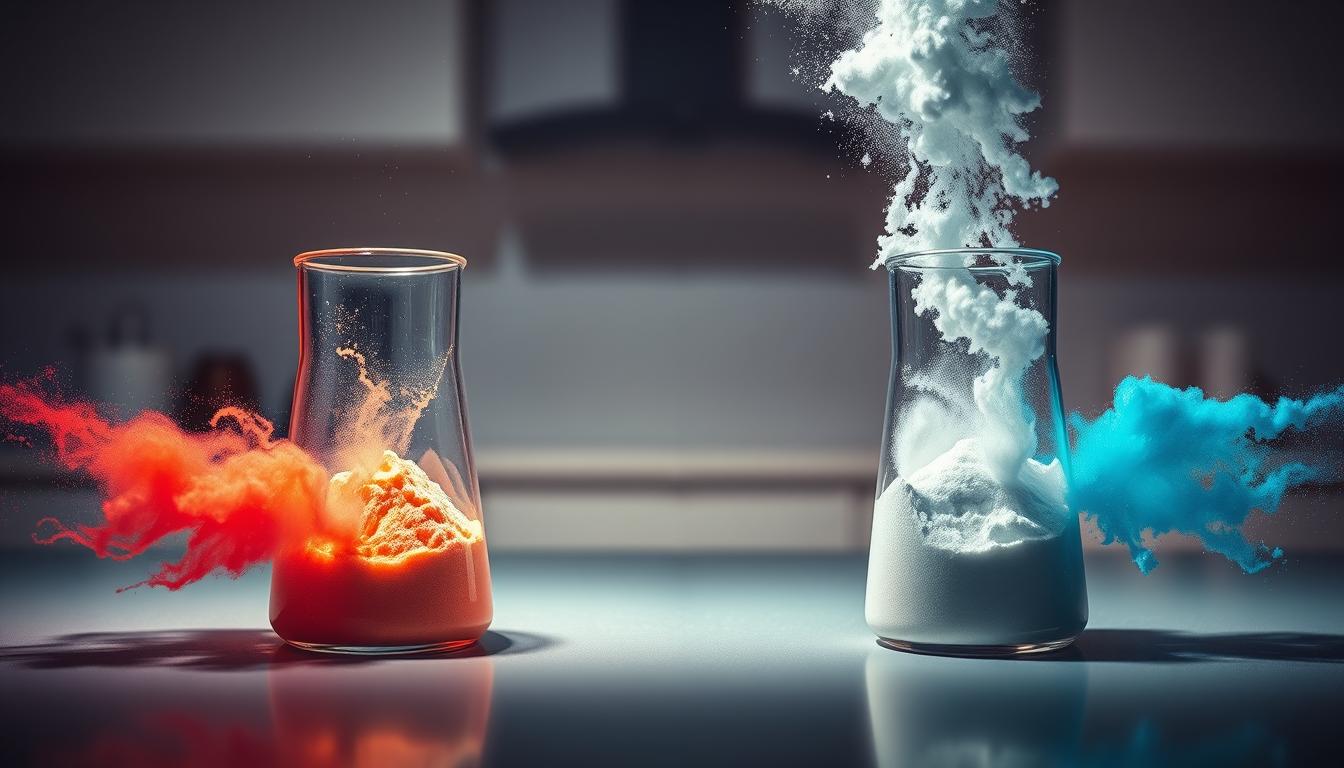Hidden in your pantry are two look-alike powders that determine whether your cakes soar or sink. Leavening agents account for 63% of baking mishaps when used incorrectly, according to culinary school research. Though often confused, these kitchen staples operate through entirely different chemical processes that shape your cookies, muffins, and breads.
One reacts instantly with acidic ingredients like yogurt or lemon juice, creating air bubbles the moment moisture appears. The other contains built-in triggers that work in stages – first when mixed, then again under heat. Using the wrong one alters taste, texture, and rise patterns dramatically.
Recipes demand specific choices because these agents affect when and how carbon dioxide forms. Swap them carelessly, and you’ll get dense brownies or bitter pancakes. Some dishes even require both to balance immediate lift with sustained expansion during baking.
Key Takeaways
- Chemical makeup determines activation methods (acidic ingredients vs. moisture alone)
- Reaction timing impacts when batters must be baked
- Substitution requires precise measurement adjustments
- Combined use optimizes rise and flavor in complex recipes
- Storage conditions affect potency over time
Understanding the Science Behind Leavening Agents
What transforms dense batter into fluffy cakes? The answer lies in chemistry. Leavening agents work through precise reactions that release carbon dioxide gas – the invisible architect behind your baked goods’ rise.

How Baking Soda Creates Carbon Dioxide
Pure sodium bicarbonate (its scientific name) acts like a chemical fire extinguisher – it’s alkaline with a pH above 7. This base needs acidic partners like lemon juice or yogurt to activate. When they meet, bubbles form instantly. This reaction peaks within 10 minutes, so you can’t let batter sit. Ever wondered why some banana bread recipes demand immediate baking? This science explains it – try making banana bread in a rice, and you’ll see why timing matters.
The Mechanism of Baking Powder’s Double Action
While its cousin needs external acids, baking powder brings its own. Cream of tartar (an acid salt) and cornstarch team up with sodium bicarbonate. Double-acting varieties release gas twice:
- 30% during mixing
- 70% when oven heat hits 140°F
This staged release lets batters rest without collapsing. Most store-bought versions work this way, giving you flexibility between mixing and baking.
Baking Soda vs. Baking Powder: Explosive Differences
Mistaking one for the other could turn your dessert into a disaster. These leaveners work through distinct chemical pathways that demand precise measurement and timing. Get the ratios wrong, and you’ll face collapsed cakes or bitter aftertastes.

Unveiling Key Chemical Reactions
Sodium bicarbonate (baking soda) packs 3-4 times more lifting power than its counterpart. That’s why recipes often use just ¼ teaspoon per cup of flour. When combined with acids like buttermilk or honey, it releases carbon dioxide instantly. Delay baking, and those bubbles vanish.
Baking powder contains cream of tartar to activate its base. Double-acting varieties produce gas twice: once during mixing, and again in the oven. This staged reaction gives batters more flexibility before hitting the heat.
Conversion Techniques for Optimal Baking
Need to substitute? Use this table for precise adjustments:
| Substitution Type | Ingredients | Ratio |
|---|---|---|
| Baking Powder → Soda | 1 tsp baking powder | ¼ tsp soda + ½ tsp cream tartar |
| Acid Alternative | Lemon juice/vinegar | ¼ tsp soda + 1 tsp acid |
| Soda → Powder | 3 tsp baking powder | = 1 tsp baking soda |
Test freshness regularly. Mix 1 teaspoon of powder with warm water – bubbles mean it’s active. For soda, combine ¼ teaspoon with vinegar. No fizz? Toss it.
Overdo sodium bicarbonate, and metallic flavors emerge. Stick to tested ratios, and your banana bread will rise perfectly every time.
Recipes and Practical Applications in Your Kitchen
Your culinary creations rise or fall based on one critical choice: which leavener to use. Acidic components like yogurt or lemon juice act as secret signals in your recipe, dictating whether you’ll need baking soda’s immediate reaction or baking powder’s delayed lift.
When to Use Baking Soda in Your Recipes
Reach for the orange box when your ingredients list includes tangy buttermilk, rich cocoa, or sticky molasses. These acidic elements activate sodium bicarbonate instantly, creating air pockets that give quick breads their signature lightness. Cookies benefit doubly – the alkaline nature promotes caramelization for golden edges while weakening gluten for tender centers.
Ever wondered why pancake batter spreads perfectly? It’s the soda at work. As one pastry chef notes: “That ¼ teaspoon difference between spread and puff separates good cookies from great ones.”
Choosing Baking Powder for Acid-Free Recipes
Vanilla cakes and crumb muffins demand this self-contained leavener. Since it contains built-in acids, you get reliable rise without altering flavors. Double-acting varieties prove essential for recipes requiring resting time – the second heat-activated burst ensures oven spring.
Buttermilk biscuits showcase strategic teamwork. The soda neutralizes some acidity for lift, while powder maintains flakiness without killing the tang. This balanced approach creates layered textures that single agents can’t achieve.
Remember the chef’s mantra: “Powder puffs, soda spreads.” Keep this in mind when modifying recipes or troubleshooting flat cookies. Your baked goods will thank you with perfect crumb structures and consistent results.
Conclusion
Mastering your kitchen’s chemistry unlocks consistent baking triumphs. The difference between these leavening agents isn’t just technical—it’s transformational. While both create lift, one demands acidic partners while the other works independently. This distinction shapes everything from cookie spread to cake height.
You now hold the keys to smart substitutions. Need to swap agents? Adjust ratios precisely—three parts powder equals one part soda. Always check freshness yearly, as expired products sabotage results. Store both in airtight containers away from moisture.
Remember: these powders are teammates, not twins. Combining them in recipes like buttermilk biscuits delivers layered textures single agents can’t achieve. With this knowledge, you’ll troubleshoot flat cakes or bitter flavors confidently.
Your baked creations now rise on science, not guesswork. Keep that orange box and silver canister fresh, and watch muffins dome perfectly every time. That’s the power of understanding kitchen chemistry.



